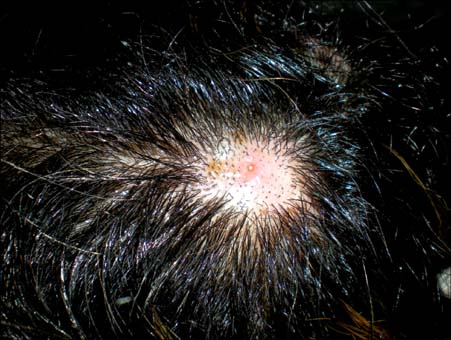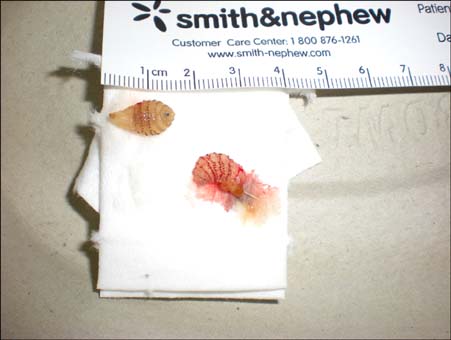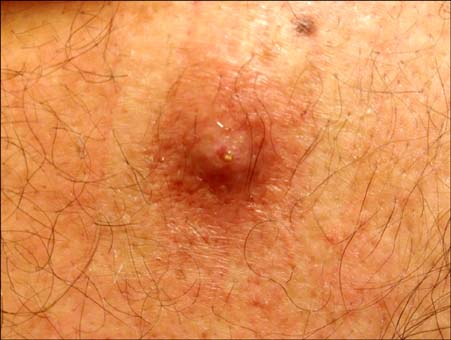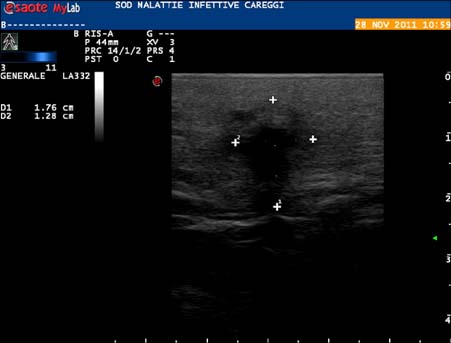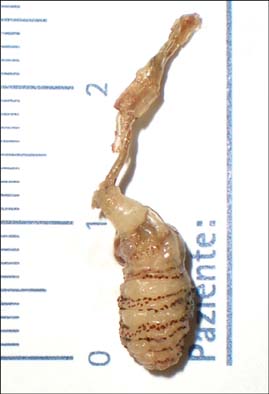Ann Dermatol.
2014 Oct;26(5):632-635. 10.5021/ad.2014.26.5.632.
Dermatobia hominis: Small Migrants Hidden in Your Skin
- Affiliations
-
- 1Infectious Diseases Unit, Department of Experimental and Clinical Medicine, University of Florence, Florence, Italy. alessandro.bartoloni@unifi.it
- 2General Surgery Unit, Department of General, Emergency and Mininvasive Surgery, Careggi Hospital, Florence, Italy.
- KMID: 2265503
- DOI: http://doi.org/10.5021/ad.2014.26.5.632
Abstract
- Myiasis is a parasitic infestation of vertebrate animal tissues due to maggots of two-winged flies (Diptera) that feed on living or necrotic tissue. Dermatobia hominis occurs widely in tropical parts of Latin America; it is the most common cause of furuncular myiasis in this region. The continuous increase in international travel has increased the possibility of observing this pathology outside endemic countries, especially in travelers returning from the tropics. If clinicians are aware of the possibility of the disease and its treatment options, this dermatosis can be easily managed. However, diagnostic delay is very common because the disease is often misdiagnosed as a bacterial skin infection. Here, we report 2 cases of furuncular myiasis caused by D. hominis in travelers returning to Italy from Latin America. Surgical and noninvasive treatment approaches are also described.
Keyword
MeSH Terms
Figure
Reference
-
1. Robbins K, Khachemoune A. Cutaneous myiasis: a review of the common types of myiasis. Int J Dermatol. 2010; 49:1092–1098.
Article2. Maier H, Hönigsmann H. Furuncular myiasis caused by Dermatobia hominis, the human botfly. J Am Acad Dermatol. 2004; 50:2 Suppl. S26–S30.
Article3. Francesconi F, Lupi O. Myiasis. Clin Microbiol Rev. 2012; 25:79–105.
Article4. Leite RC, Rodríguez Z, Faccini JL, Oliveira PR, Fernandes AA. First report of Haematobia irritans (L.) (Diptera: Muscidae) as vector of Dermatobia hominis (L.jr.) (Diptera: Cuterebridae) in Minas Gerais, Brazil. Mem Inst Oswaldo Cruz. 1998; 93:761–762.
Article5. Hochedez P, Caumes E. Common skin infections in travelers. J Travel Med. 2008; 15:252–262.
Article6. Rizzo G, De Vito D, Rizzo C. A case of cutaneous myiasis caused by Dermatobia hominis. Parassitologia. 1998; 40:335–337.7. Veraldi S, Gorani A, Süss L, Tadini G. Cutaneous myiasis caused by Dermatobia hominis. Pediatr Dermatol. 1998; 15:116–118.
Article8. Guidi B, Olivetti G, Sbordoni G, Garcovich A. Guess what! Diagnosis: cutaneous myiasis due to dermatobia hominis. Eur J Dermatol. 2001; 11:259–260.9. Matera G, Liberto MC, Larussa F, Barreca GS, Focà A. Human myiasis: an unusual imported infestation in Calabria, Italy. J Travel Med. 2001; 8:103–104.10. Romano C, Albanese G, Gianni C. Emerging imported parasitoses in Italy. Eur J Dermatol. 2004; 14:58–60.11. Bongiorno MR, Pistone G, Aricò M. Myiasis with Dermatobia hominis in a Sicilian traveller returning from Peru. Travel Med Infect Dis. 2007; 5:196–198.
Article12. Varani S, Tassinari D, Elleri D, Forti S, Bernardi F, Lima M, et al. A case of furuncular myiasis associated with systemic inflammation. Parasitol Int. 2007; 56:330–333.
Article13. Calderaro A, Peruzzi S, Gorrini C, Piccolo G, Rossi S, Grignaffini E, et al. Myiasis of the scalp due to Dermatobia hominis in a traveler returning from Brazil. Diagn Microbiol Infect Dis. 2008; 60:417–418.
Article14. Veraldi S, Francia C, Persico MC, La Vela V. Cutaneous myiasis caused by Dermatobia hominis acquired in Jamaica. West Indian Med J. 2009; 58:614–616.15. Schwartz E, Gur H. Dermatobia hominis myiasis: an emerging disease among travelers to the Amazon basin of Bolivia. J Travel Med. 2002; 9:97–99.
Article16. Diaz JH. The epidemiology, diagnosis, management, and prevention of ectoparasitic diseases in travelers. J Travel Med. 2006; 13:100–111.
Article17. Loong PT, Lui H, Buck HW. Cutaneous myiasis: a simple and effective technique for extraction of Dermatobia hominis larvae. Int J Dermatol. 1992; 31:657–659.
Article18. Boggild AK, Keystone JS, Kain KC. Furuncular myiasis: a simple and rapid method for extraction of intact Dermatobia hominis larvae. Clin Infect Dis. 2002; 35:336–338.
Article
- Full Text Links
- Actions
-
Cited
- CITED
-
- Close
- Share
- Similar articles
-
- A Case of Furuncular Cutaneous Myiasis by Dermatobia hominis
- Furuncular Myiasis in a Traveler Returning from South America
- A Patient with Fatal Septicemia Caused by a Rare Pathogen Dermabacter Hominis
- A Case of Misidentification of Dermabacter hominis as Listeria grayi
- Two Cases of Extragenital Infection by Mycoplasma hominis

